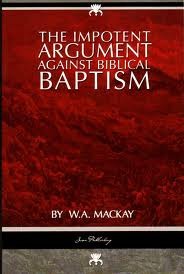| Contextual Evidence Shedding Light on Baptism: Contextual evidence is, in my mind, the weakest of all the arguments I will put forward. In and of itself, context of the distant past often involves a bit of conjecture. We have to fill in the gaps with what we think we know of the time, place, and people, as details of the text are often too sparse to paint a whole picture. However, when you add contextual evidence to the rest of the cumulative case, it tends to be the glue that holds everything together. If you can interpret a passage two different ways, then you get a story that applies some of the concepts in a real life example, that story can sometimes provide the context to shed light on unclear passages. The passages where we see baptism applied can help to shed light on what is actually said in the unclear passages, as we get to see what the authors of the NT actually did (or may have done). I provide several instances below that hit on both the mode and the object. |
- Some cite Jesus's baptism as an example of immersion where he "comes up out of the water" in Matthew 3. Just as with the eunuch example it's easy to see that John the Baptist likely also came up out of the water yet he wasn't baptized. It makes more sense that we're speaking of walking down a bank into the water and back up out. Christ's baptism in Mark 1 makes this notion of consecration even more convincing as we see that immediately following Christ's baptism, the Spirit drove him into the desert. This seems to extend the notion of being set apart or dedicated to God. When you couple this with the imagery of the Spirit coming upon Christ given directly in the passage, as well as the OT consecration through sprinkling, Christ's baptism makes just as much, if not more sense as a sprinkling/pouring instance.
- The logistics of mass immersions seems highly improbable. Not only are some of the places mentioned for baptisms watered sparsely or with shallow water, but the multitude of individuals who were baptized could not have been handled logistically (or at least such a feat is hard to fathom). When John the Baptist baptized the masses that he did in the short period of his ministry, or when Peter baptized the 3,000 or so converts after his sermon, how was everyone baptized so quickly? With hostility by the Jews in some of these regions, access to a public water supply of sufficient size and for a sufficient time to immerse a crowd, the lack of sufficient water supply in certain regions, the great masses in need of baptism, or the logistics of decency when baptizing by immersion (did the mixed crowds disrobe to get baptized? Did they bring a spare change of clothes? We're often not talking of planned baptisms but rather baptisms at the spur of the moment). In Hebrews 9:19 we see how baptism could have been easily accomplished by a sprinkler with such logistical limitations. They could simply take a hyssop branch, as would have been familiar to them from some of their customs in the OT, and after dipping it in the element, waving it over a large number of people. You can see more verses on hyssop here, and you can notice how it commonly accompanies water or blood and sprinkling. Such a method not only makes much sense out of how the large congregation of Israel may have been baptized during some of their public ceremonies, but also how John the Baptist or Peter could baptize so many people in such a short period of ministry. Waving a hyssop branch over a crowd could make very short work of baptizing a crowd the size of the one Peter baptized. It could also be done with very little water in this manner and with no issues in regard to spontaneous baptisms as it related to decency or clothing changes.
- The notion of baptism as a consecration seems clear. While consecration or setting apart may involve cleansing from sin, some examples in the OT show a sprinkling or pouring used for a setting apart of rather than a cleansing of. Anointing by pouring oil over one's head is the first major reference that comes to mind. Matthew 3:15 declares that Jesus had to be baptized to fulfill all righteousness. If Jesus was not in need of a cleansing from sin, the symbolism represented under immersion is difficult to explain. Did Jesus need to die to his sinful self on the cross as depicted in an immersive baptism? This site goes into a much more detailed explanation of why Christ would have to be baptized. I think it is worth pursuing if you find this aspect interesting. If light is shed on Christ's baptism it may also help to shed some light on how he intended baptism to be done for his followers if his specific baptism is prescriptive for us. Even if Christ's specific baptism isn't for us, understanding that the process and symbolism aren't what most credobaptists claim today is helpful to undercut their argument.
- Consecration along with cleansing make sense of the family baptisms we see. I Corinthians 1:16 and Acts 10 show us two baptisms where households were baptized. We find also find two household baptisms in Acts 16. The second baptism in Acts 16, the one of the Philippian jailer, is the most interesting for our discussion. When the jailer accepts the gospel, he and his household were baptized. Now if it were just the jailer and his wife, we presume the word "household" would not have been included. Presumably there were others in the household, possibly children. While that is a nod towards a potential example of the baptism of individuals under the representation of their believing parent or head, though of course that is inconclusive, it also takes away credibility from immersionists. If the jailer was in charge of watching the jail - the jail that just had all the prisoners unlocked on its own - it's the middle of the night, there is a decent chance that in a "household" either children or elderly are present - then were they really to go down to a river or some other significant body of water in the middle of the night (also considering they likely didn't have swimming pools, so any sufficient body of water was likely very public)? Paul is in jail, so obviously the region is pretty hostile to Christianity. What kind of scene would an immersive baptism require and how does that work logistically? While none of these household baptisms say that infants or children were involved, and none of the baptisms say that sprinkling or pouring was the method, it seems very likely that there were some who were baptized in at least one of the households who could not believe due to their age. And in the case of the Philippian jailer, it seems that immersion was most likely not the method used.
PREVIOUS: Part 3: The Family and Federal Headship NEXT: Part 5: Church History





 RSS Feed
RSS Feed